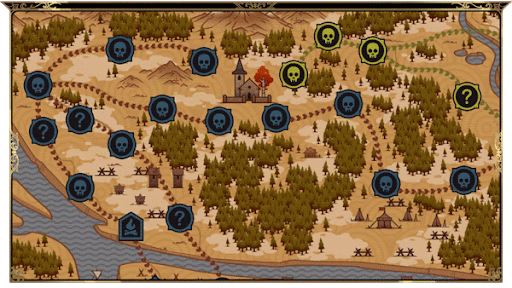Let’s talk to the Redboon studio’s head about the idea of the creation of Knock on the Coffin Lid
Hello everyone! Knock on the coffin lid is a plot-driven, rogue-like card game with a twisted story that any classic fantasy novel would envy.
Dynamic card battles in the epic setting of the magical world await you! Make difficult decisions that directly affect the course of events.
Learn new details of the fascinating story which the characters of the game were pulled into by the will of fate.
It’s time to talk to the Redboon studio head Andrei Medvedev himself.
How did the idea of the game come about?
Randomly, after the Slay the Spire hype. We’d been making a turn-based card game, a combination of Hearthstone and UFO. But we realized that we couldn’t handle such a project, especially as our first. Slay the Spire just came out. We liked the mechanics, but it lacked plot, and many didn’t like the visuals. So we just went for it 🙂
Did the concept of Knock on the Coffin Lid’s plot change during the development?
The world in which the game takes place was invented before the game itself, at the dawn of the studio’s existence, during our creative searches. The game itself doesn’t aim to tell everything about its world; it only exists in this world, obeying its laws and logic. The concept of the game’s world remains unchanged throughout the development.
The game’s plot concept was practically not rewritten, but it was expanded and fleshed out at a dramatic rate. First there was one character, and then we decided to make three. Then we had an idea to make unique texts for all the characters, and if you need to rewrite the texts, then why not tell three stories at once instead of one? Or we could at least show the same events from different points of view, add some details, tell more about everything that’s happening. As it turned out later, this was just the beginning.
When we started thinking about the endgame content, it was decided not to limit ourselves to the game mechanics — the story should also go on. Since the characters are locked inside a time loop, “continuation” in the classical sense of the word is impossible. But the plot doesn’t freeze; it lives on, acquiring new details.
The main task at this stage is to give the player a complete idea that all the events are interconnected, and that all the characters that the heroes meet along the way are not there by accident — they are part of the global picture that unfolds in front of the player. Fortunately, this task isn’t as difficult as it may seem at first, because, from the very start, there were no events and characters “detached from reality” in the game.
What does the path from the idea to the actual development of your own project look like? Like a snowball. First, the core of the game is made — rules, mathematics, and parameters are invented. Then you start building up the game. And here’s when an endless stream of ideas turn into infinite Trello cards. This is the main reason why the game has been taking so long to be made
An indiscreet question: how much does it cost to develop your own game? It’s hard to say exactly. We spend what we earn from other jobs and freelancing on the game. In the moment, it doesn’t seem like “a lot”. But when the development is delayed, it’s scary to look back at the costs. The expenses can scare and demoralize you. We try not to look back at it:) After all, we’re not doing this for money. We like the process itself. But we definitely want to make money to have more time for our next game.
Traditional question: imagine that the work on KOTCL is completed and all roads open up for you. What game genre would you like to work on in the future? I haven’t thought about that yet, because we have not yet implemented everything we wanted in KOTCL.

